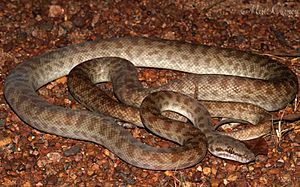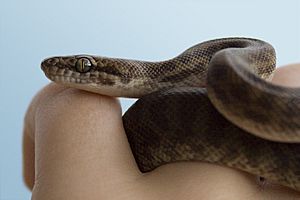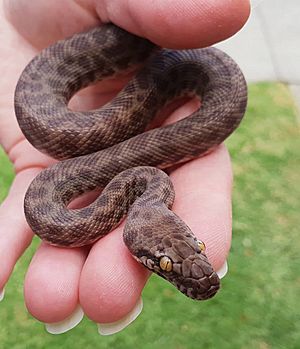Children's python facts for kids
Quick facts for kids Antaresia childreni |
|
|---|---|
 |
|
| Children's python | |
| Scientific classification | |
| Genus: |
Antaresia
|
| Species: |
childreni
|
| Synonyms | |
|
|
The Children's python (Antaresia childreni) is a type of snake that is not venomous. It belongs to the Pythonidae family. This snake is named after John George Children. It is active at night and lives in the northern parts of Australia. You can usually find it on the ground, but it also likes to climb trees.
Children's pythons usually grow to about 1 meter (3.3 feet) long. They are typically reddish-brown, with a darker color on their back. Younger snakes often have many darker spots. These pythons mostly eat small mammals and birds. Like other pythons, they squeeze their prey before swallowing it whole. Many people who like reptiles keep Children's pythons as pets because they are easy to care for.
Contents
What's in a Name? The Children's Python Story
The Children's python is one of four types of snakes in the Antaresia group. This group is part of the Pythonidae family. The name Antaresia comes from the star Antares.
A scientist named John Edward Gray first described this snake in 1842. He called it Liasis childreni. Both the common name, Children's python, and the scientific name, childreni, honor Gray's teacher. His teacher was John George Children. He worked as a curator, or keeper, of animal collections at the British Museum a long time ago. No different types (subspecies) of Children's python are known today. Some snakes in the Antaresia group used to be in a different group called Morelia.
Meet the Children's Python: Appearance and Features
Adult Children's pythons can grow to be about 1 to 1.5 meters (3.3 to 4.9 feet) long, including their tail. The scales on top of their head are larger than the ones on their body. The scales on their body are small and smooth. If you see them in direct sunlight, they can show a beautiful rainbow shine!
The snake's back is brown with darker spots. These spots often form five or six lines along its body. There is a dark line on each side of its head that goes across its eye. Its lips are yellowish and have brown spots. The underside of the snake is a plain yellowish color.
The head of the Children's python is easy to tell apart from its neck. Its body is a bit flat on the sides. The tail is short. This snake has about 41 to 45 rows of scales across its back. It also has 257 to 287 scales along its belly. There is one single scale in front of its bottom opening (anus). It has 38 to 53 scales on the underside of its tail, which are usually in two rows.
Where Do Children's Pythons Live?
You can find the Children's python in the northern part of Australia. They live in the far north of Western Australia, the northern third of the Northern Territory, and northeastern Queensland. They also live on the islands in the Torres Strait.
Specifically, they live along the coast. This area stretches from the Kimberleys in Western Australia to Mount Isa in northwestern Queensland.
What Do Children's Pythons Eat?
Children's pythons eat other reptiles, birds, and small mammals. They especially like to eat microbats. These snakes often live in caves. They catch bats by hanging from the cave ceiling and grabbing them out of the air as they fly by.
Reproduction and Life Cycle
A. childreni snakes lay eggs. A female can lay up to 25 eggs at a time. After laying her eggs, the mother snake coils around them. She stays wrapped around her eggs for about seven weeks until they hatch. She sometimes shivers her body to keep the eggs warm. This also helps protect the eggs from animals that might try to eat them. When they are young, Children's pythons have many spots. As they get older, their color slowly changes to reddish-brown or brown.
Children's Pythons as Pets
Children's pythons are popular pets. This is because they are generally calm and do not need too much special care. Some Children's pythons kept as pets have lived for more than 30 years!
Young pythons are fed small, hairless mice. As they grow bigger, they can eat adult mice or small rats. It is usually best to feed them about once every two weeks.





